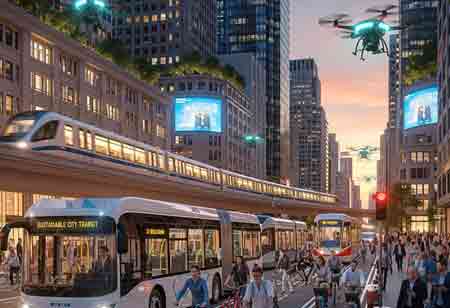Thank you for Subscribing to Gov Business Review Weekly Brief
Modernizing Municipal Transportation for a Multi-Modal Future
E-commerce, micromobility, and new work paradigms are reshaping urban transport. Municipal policies lag, creating a governance gap that cities must address to achieve sustainable and efficient mobility.

By
Gov Business Review | Tuesday, August 19, 2025
Stay ahead of the industry with exclusive feature stories on the top companies, expert insights and the latest news delivered straight to your inbox. Subscribe today.
The confluence of e-commerce, the sharing economy, micromobility, and evolving work-life paradigms is actively reconfiguring the urban environment, fundamentally altering the movement of individuals and commodities within metropolitan areas. Nevertheless, the administrative frameworks governing this movement frequently remain rooted in a past era. This discrepancy engenders a substantial governance deficit: a growing divergence between the on-demand reality of 21st-century mobility and the static, fragmented policies of the 20th century. Addressing this disparity is no longer a theoretical exercise; it constitutes the paramount objective for municipalities endeavoring to cultivate more efficient, equitable, and sustainable communities. The modernization of municipal parking and transportation policies necessitates a fundamental re-evaluation, not merely of the regulations themselves, but also the core philosophy and structural paradigm of urban governance.
The Legacy of a Static Worldview
For decades, municipal transportation governance was built on a foundation of predictability and separation. Departments operated in well-defined silos. The public works department managed roads, the transit authority ran buses and trains, and the planning department oversaw land use. Each functioned with a distinct mandate, often with minimal strategic integration.
Within this structure, parking was treated not as a component of the mobility network, but as a static land-use requirement—a place to store a private vehicle. The primary policy tools were blunt instruments: minimum parking requirements embedded in zoning codes, mandating a set number of spaces for every new development, and simple, fixed-rate parking meters designed to generate revenue. The overarching goal was accommodation. Success was measured in terms of vehicle throughput and the ample availability of storage, a model that implicitly prioritized the private automobile above all other modes of transport. This framework was logical for its time, designed for a world of nine-to-five commutes to a central business district. Still, it lacks the agility to manage the fluid, multi-modal ecosystem of today.
The Emergence of a Mobility Ecosystem
The last decade has rendered the old model obsolete. Urban transportation is no longer a simple choice between driving and taking the bus. It is a complex, interconnected ecosystem teeming with new options and vast streams of data. Shared mobility services—from ride-hailing to docked and dockless bikes and scooters—have introduced a new layer of on-demand transportation that utilizes public space in entirely new ways.
The most significant shift has occurred at the curb. Once a simple line for parked cars, the curbside has become one of the most valuable and contested pieces of urban real estate. It is now a zone for e-commerce deliveries, passenger pickups and drop-offs, food delivery staging, and micromobility parking. Simultaneously, the digital revolution has armed city planners with an unprecedented toolkit. Real-time data from sensors, payment systems, and connected vehicles offers a granular, second-by-second understanding of traffic congestion, parking occupancy, and transit patterns. This new reality— data-rich and multi-modal—demands a governance model that is equally sophisticated and responsive.
Principles for Modern Governance
Closing the governance gap requires a deliberate departure from outdated paradigms and the adoption of modern operating principles. This transformation is not about identifying a singular technological solution but about developing institutional capacity for adaptive management. At its core, modernization demands integrated governance, data-driven decision-making, and flexible regulatory frameworks that enable cities to respond effectively to evolving mobility needs.
A critical first step lies in dismantling institutional silos and fostering integrated governance structures. Many forward-thinking municipalities are establishing unified Departments of Mobility, consolidating functions such as traffic engineering, parking management, transit coordination, pedestrian and bicycle infrastructure, and new mobility regulation under one strategic framework. This holistic approach enables cities to view and manage transportation networks as interconnected systems rather than isolated components. In this model, parking policy becomes a tool to incentivize transit use, and street design evolves from merely accommodating vehicles to creating safe, inclusive, public spaces. Such integration ensures that policies and actions align, advancing broader urban objectives including improved air quality, enhanced public safety, and stronger economic vitality.
Equally important is a shift toward data-centric policy and operations. Traditional reliance on sporadic traffic counts and anecdotal evidence is giving way to real-time, continuous data collection through in-ground sensors, smart meters, and mobile applications. This wealth of information enables municipalities to replace static rules with dynamic management strategies. A leading example is performance-based pricing, in which parking costs adjust according to demand to maintain availability. The aim is not revenue maximization but efficiency—reducing unnecessary circulation, easing congestion, and ensuring curb space is available for high-value uses. Data-driven governance equips cities with precise tools to balance access, mobility, and sustainability in real-time.
A modern governance framework must embrace proactive and adaptive regulation. Recognizing that innovation often outpaces traditional policy cycles, cities are increasingly adopting flexible approaches such as regulatory sandboxes and pilot programs. These mechanisms enable the controlled testing of new mobility services while establishing clear, outcome-based performance standards regarding equity, maintenance, and data sharing. In return for operating rights, private providers supply anonymized data that supports effective planning and oversight. This collaborative, test-and-learn model fosters innovation while safeguarding public interests, ensuring that emerging services align with and advance municipal mobility goals.
A modern city becomes reality when these principles create seamless, user-centric mobility. A commuter can utilize a single application to plan and compensate for a journey that may include a train ride, a brief e-scooter excursion, and a walk, all guided by real-time information. Digital signage directs delivery drivers to designated loading zones, while smart traffic signals adjust their timing based on actual traffic flow. Parking prices also manage demand throughout the day. A city where equitable policies make innovative transportation accessible and affordable for all, creating a more efficient, livable, and resilient urban environment.






